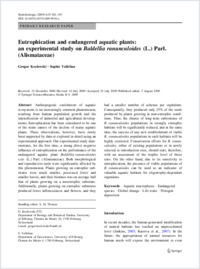Eutrophication and endangered aquatic plants : an experimental study on Baldellia ranunculoides (L.) Parl. (Alismataceae)
- Kozlowski, Gregor Department of Biology and Botanical Garden, University of Fribourg, Switzerland
- Vallelian, Sophie Department of Geosciences, University of Fribourg, Switzerland
-
05.08.2009
Published in:
- Hydrobiologia. - 2009, vol. 635, no. 1, p. 181-187
English
Anthropogenic enrichment of aquatic ecosystems is an increasingly common phenomenon, resulting from human population growth and the intensification of industrial and agricultural developments. Eutrophication has been considered to be one of the main causes of the decline of many aquatic plants. These observations, however, have rarely been supported by data or explored in detail using an experimental approach. Our experimental study demonstrates, for the first time, a strong direct negative influence of eutrophication on the performance of the endangered aquatic plant Baldellia ranunculoides s.str. (L.) Parl. (Alismataceae). Both morphological and reproductive traits were significantly affected by this phenomenon. Plants growing on eutrophic substrates were much smaller, possessed fewer and smaller leaves, and their biomass was on average half that of plants growing on a mesotrophic substrate. Additionally, plants growing on eutrophic substrates produced fewer inflorescences and flowers, and they had a smaller number of achenes per capitulum. Consequently, they produced only 15% of the seeds produced by plants growing in non-eutrophic conditions. Thus, the chance of long-term subsistence of B. ranunculoides populations in strongly eutrophic habitats will be significantly reduced, and at the same time, the success of any new establishment of viable B. ranunculoides populations in such habitats will be highly restricted. Conservation efforts for B. ranunculoides, either of existing populations or in newly selected re- introduction sites, should start, therefore, with an assessment of the trophic level of those sites. On the other hand, due to its sensitivity to eutrophication, the presence of viable populations of B. ranunculoides can be used as an indicator of valuable aquatic habitats for oligotrophy-dependent organisms.
- Faculty
- Faculté des sciences et de médecine
- Department
- Département de Géosciences, Département de Biologie
- Language
-
- English
- Classification
- Biology, life sciences
- License
- License undefined
- Identifiers
-
- RERO DOC 13182
- DOI 10.1007/s10750-009-9910-x
- Persistent URL
- https://folia.unifr.ch/unifr/documents/301338
Statistics
Document views: 84
File downloads:
- 10750_2009_Article_9910.pdf: 182
